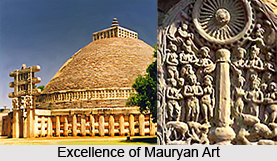 Usage of grey sandstone in sculpture is one of the major features of Mauryan art. This brought about a change in the scenario of Indian art. Mauryan art is considered as the first organised art activity in India on a large scale basis. Mauryan treasury of art include: the remains of the royal palace and city of Pataliputra; a monolithic rail at Sarnath; the Bodhimanda or the altar resting on four pilasters at Bodhgaya; the excavated chaitya-halls in the Barabar and Nagarjuni hills of Gaya which also including the Sudama cave, the non-edict bearing and edict-bearing pillars, the animal sculptures crowning the pillars with animal and vegetal reliefs and the front half of the representation of an elephant carved at Dhauli in Orissa.
Usage of grey sandstone in sculpture is one of the major features of Mauryan art. This brought about a change in the scenario of Indian art. Mauryan art is considered as the first organised art activity in India on a large scale basis. Mauryan treasury of art include: the remains of the royal palace and city of Pataliputra; a monolithic rail at Sarnath; the Bodhimanda or the altar resting on four pilasters at Bodhgaya; the excavated chaitya-halls in the Barabar and Nagarjuni hills of Gaya which also including the Sudama cave, the non-edict bearing and edict-bearing pillars, the animal sculptures crowning the pillars with animal and vegetal reliefs and the front half of the representation of an elephant carved at Dhauli in Orissa.
They are monumental in conception and design, thorough and precise in execution. Excepting the remains of royal palace and city-buildings of Pataliputra all of them were made in hard grey sandstone. They are finely chiselled and highly polished that is incomparable in India of later ages. All of them were nurtured up under the shadow of the royal throne of the Mauryas, Ashoka and his grandson.
All removable pieces were worked made of grey sandstone quarried at Chunar except those carved out of live rock. The Mauryan columns are all carved out of this material, and these are distributed over a very wide area, between Delhi in the west, Basarh in the east and Sanchi in the south. Mauryan emperors initiated the artists and art-guilds into the use of stone and made them translate their traditional skill in terms of a new material.
Stone sculpture was introduced by Mauryan dynasty which expressed a civilised, sophisticated and fully developed art that had generations of artistic effort, experience and tradition behind it. Mauryan sculptures represent the technical skill and efficiency of the Mauryan sculptor who worked in stone of huge and heavy proportions. Animals, palmettes, rosettes, and bell-capitals were common elements of the craftsman`s repertory under the Nandas as well as the Mauryas.
Hellenophilism brought Mauryan Empire into an indirect contact with the art and culture of the Achaemenids. Mauryan art was a product of the Mauryan court. Mauryan court and its presiding lords were all Hellenophils and were under the influence of Achaemenian art and culture at the same time. Grey sandstone was handled well that was used for sculptural and architectural purposes.
Mauryan art was unable to conceive life and things in huge proportions and large dimensions. Mauryan art happened to be the storehouse of certain patterns, designs, and motifs that India shared in common with the rest of the early Asiatic world.



















